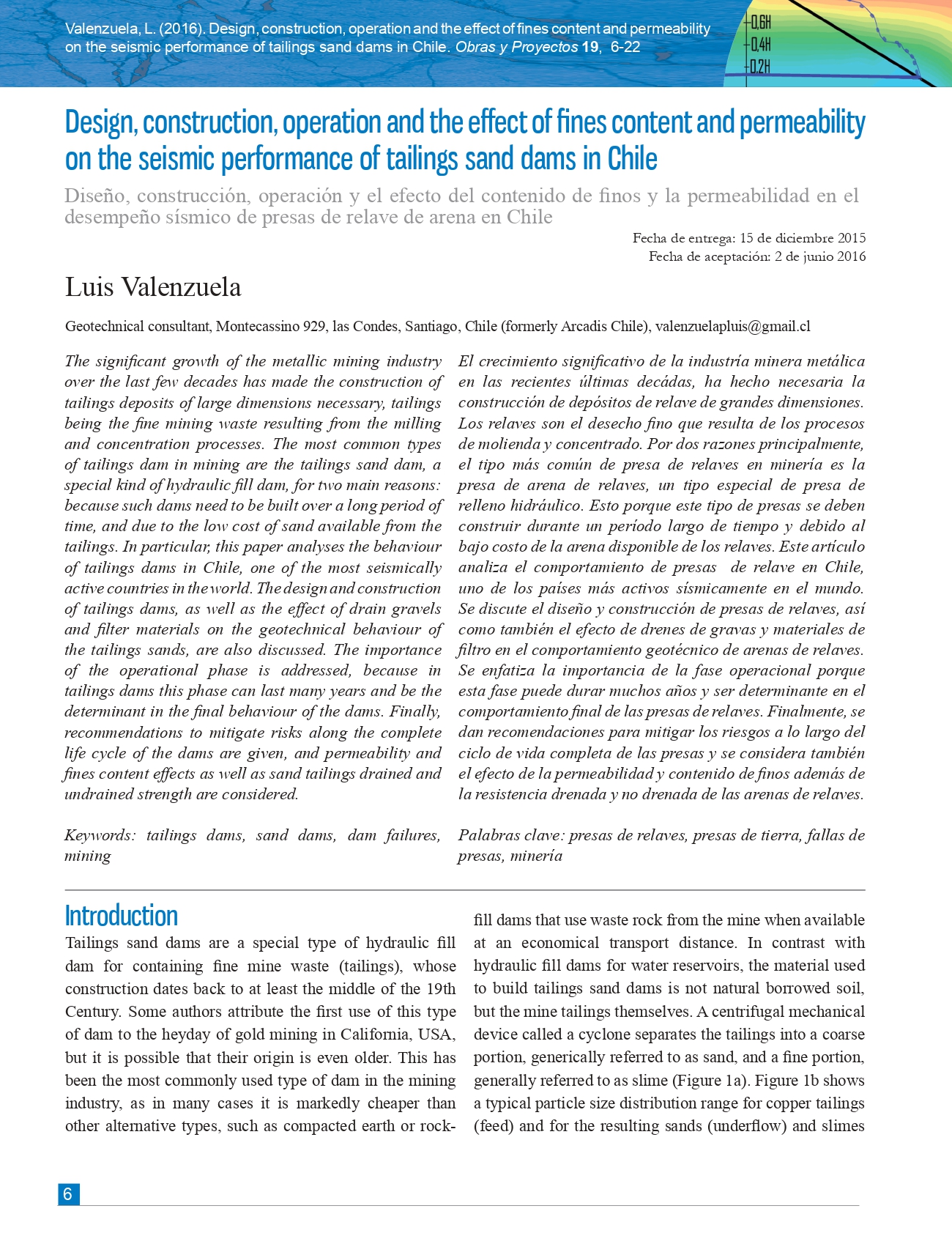Diseño, construcción, operación y el efecto del contenido de finos y la permeabilidad en el desempeño sísmico de presas de relave de arena en Chile
DOI:
https://doi.org/10.4067/S0718-28132016000100001Palabras clave:
presas de relaves, presas de tierra, fallas de presas, mineríaResumen
El crecimiento significativo de la industria minera metálica en las recientes últimas decádas, ha hecho necesaria la construcción de depósitos de relave de grandes dimensiones. Los relaves son el desecho fino que resulta de los procesos de molienda y concentrado. Por dos razones principalmente, el tipo más común de presa de relaves en mineria es la presa de arena de relaves, un tipo especial de presa de relleno hidráulico. Esto porque este tipo de presas se deben construir durante un periodo largo de tiempo y debido al bajo costo de la arena disponible de los relaves. Este articulo analiza el comportamiento de presas de relave en Chile, uno de los países más activos sísmicamente en el mundo. Se discute el diseño y construcción de presas de relaves, asi como también el efecto de drenes de gravas y materiales de filtro en el comportamiento geotécnico de arenas de relaves. Se enfatiza la importancia de la fase operacional porque esta fase puede durar muchos años y ser determinante en el comportamiento final de las presas de relaves. Finalmente, se dan recomendaciones para mitigar los riesgos a lo largo del ciclo de vida completa de las presas y se considera también el efecto de la permeabilidad y contenido de finos además de la resistencia drenada y no drenada de las arenas de relaves.
Referencias
Agüero, G. (1929). Formación de depósitos de relaves en el mineral de El Teniente. Anales del Instituto de Ingenieros de Chile 5, 164-187
Bard, E. Campaña, J. Torres, P. Valenzuela, L. y Cifuentes, L. (2014). Comportamiento de arenas a altas presiones de confinamiento: comparación entre arenas de relaves y naturales. VIII Congreso Chileno de Geotecnia, Santiago
Blight, G.E. (2010). Geotechnical engineering for mine waste storage facilities. Taylor & Francis
Campaña, J. Carmi, C. Bard, E. and Valenzuela, L. (2015). Permeability and consolidation parameters in tailings treated with seawater. XV Pan-American Conference on SoilMechanics and Geotechnical Engineering, Buenos Aires
Campaña, J., Bard, E. and Verdugo, R. (2013). Shear strength and deformation modulus of tailing sands under high pressures. Proceedings of the 18th Conference on Soil Mechanics and Geotechnical Engineering, Paris
Campaña, J. (2011). Comportamiento de arenas de relave a altas presiones. Tesis MSc, Universidad de Chile
Castro, G. and Troncoso, J.H. (1989). Seismic behavior of three tailings dams during the March 3, 1985 Earthquake. 5th Chilean Conference on Seismology and Earthquake Engineering, Santiago
Cochilco (2014). Anuario de Estadísticas del Cobre y otros Minerales 1994 - 2013. Comisión Chilena del Cobre
Conlin, B. (1987). A review of the performance of mine tailings impoundments under earthquake loading conditions. Proceedings of the Vancouver Geotechnical Society Seminar on Earthquake
Davies, M.P. Martin, T.E. and Lighthall, P. (2000). Mine tailings dams: when things go wrong. Tailings Dams 2000, Association of State Dam Safety Officials, U.S. Committee on Large Dams, 261-273
Dobry, R. and Alvarez, L. (1967). Seismic failure of Chilean tailings dams. Journal of the Soil Mechanics and Foundations Division 93(6), 237-259
Figueroa, A., Valenzuela, L., Sconagmillo, C., Santos, E. and Tascón, A. (2015). Particle - size segregation in sand tailings dams. XV Pan-American Conference on Soil Mechanics and Geotechnical Engineering, Buenos Aires
Finn, W. D. L. (1996). Seismic design and evaluation of tailings dams: state of the art. Proceedings International Symposium on Seismic and Environmental Aspects of Dams Design: Earth, Concrete and Tailings Dams, ICOLD - ISSMFE, Chilean Geotechnical Society, 7-34
ICOLD (2001). Tailings dams - risk of dangerous occurrences. Bulletin 121
ICOLD (1995). Dam failure statistical analysis. Bulletin 99
Illanes, J., Urquidi, J., Figueroa, A., Campaña, J. and Morales, F. (2015). Geotechnical instrumentation in tailings sand dams. XV Pan-American Conference on Soil Mechanics and Geotechnical Engineering, Buenos Aires
Ishihara, K. (1984). Post-earthquake failure of a tailings dam due to liquefaction of the pond deposit. Proceedings of the International Conference on Case Histories in Geotechnical Engineering, St. Louis, Missouri, 3, 1129-1143
Ishihara, K. (1993). Liquefaction and flow failure during earthquakes. Géotechnique 43(3), 351-451
Ishihara, K. Ueno, K. Yamada, S. Yasuda, S. and Yoneoka, T. (2015). Breach of a tailings dam in the 2011 earthquake in Japan. Soil Dynamics and Earthquake Engineering 68, 3-22. https://doi.org/10.1016/j.soildyn.2014.10.010
Lee, K.L. and Seed, H. (1967). Drained strength characteristics of sands. Journal of Soil Mechanics and Foundation Division 93(6), 117-141. https://doi.org/10.1061/JSFEAQ.0001048
Lo, R.C. Klohn, E.J. and Finn, W.D.L. (1988). Stability of hydraulic sandfill tailings dams. In Hydraulic Fill Structures, ASCE Geotech. 21, 549-572
Martin, T.E, Davies, M.P., Rice, S., Higgs, T. and Lighthall, P.C. (2002). Stewardship of tailings facilities. Mining, Minerals and Sustainable Development No. 20. International Institute for Environment and Development
Miura, N. and Yamanouchi, T. (1975). Effect of water on the behavior of quartz-rich sand under high stresses. Soils and Foundations 15(4), 23-34. https://doi.org/10.3208/sandf1972.15.4_23
MM (2007). Decreto Supremo N° 248. Reglamento para la aprobación de proyectos de diseño, construcción, operación y cierre de los depósitos de relaves. Ministerio de Minería de Chile
MM (1970). Decreto Supremo N° 86. Reglamento de construcción y operación de tranques de relaves. Ministerio de Minería de Chile
Murthy, T. Loukidis, D. Carrasco, J. Prezzi, M. and Salgado, R. (2007). Undrained monotic response of clean and silty sands. Géotechnique 57(3), 273-288
Obermeyer, J. and Alexieva, T. (2011). Design, construction and operation of a large centerline tailings storage facility with high rate of rise. Proc. Tailings and Mine Waste, Vancouver
Peck, R.B. (1980). Where has all the judgement gone?. The 5th Laurits Bjerrum Memorial Lecture. Canadian Geotechnical Journal 17(4), 584-590. https://doi.org/10.1139/t80-065
Priscu, C. (2014). Seguridad de presas y geotecnia - Áreas interrelacionadas. Presentation at the VIII Congreso Chileno de Ingeniería Geotécnica, Santiago
Ramirez, N. (2010). Effects of the 2010 earthquake on tailings disposals located on the South-Central Chile and its relation with Decreto 248. Seminar: Proposals for the operation of tailings disposals according to recent experiences, 2010 (in Spanish)
Scott, M.D., Lo, R.C. and Thavaraj, T (2007). Use ofinstrumentation to safeguard of tailings dams. 7th International Symposium on Field Measurements in Geomechanics, ASCE, 1-13. https://doi.org/10.1061/40940(307)56
Swaisgood, J. (2002). Investigation and evaluation of Quillayes dam. High Density and Past Seminar, Santiago, Chile
Troncoso, J.H. (2015). Personal communication to L. Valenzuela, June 2015
Troncoso, J.H. (2014). Seismic design of tailings dams - State of practice in South America. In Workshop of Seismic Design of Tailings Dams, 34th USSD Annual Meeting and Conference, San Francisco
Troncoso, J.H., Avendaño, A. and Vergara, A. (1993). The seismic failure of Barahona tailings dam. 3rd International Conference on Case Histories in Geotechnical Engineering, 1473-1479
USCOLD (1994). Tailings dams incidents. USCOLD Committee on Tailings Dams
Valenzuela, L. (2015). Tailings dams and hydraulic fills. Casagrande Lecture, XV Panamerican Conference on Soil Mechanics and Geotechnical Engineering, Buenos Aires
Valenzuela, L. (2010). Chile earthquake and its impact on infrastructure. Congresso Brasileiro de Mecánica dos Solos e Engenharia Geotecnica, Brasil
Valenzuela, L. (1996). Main characteristics of large tailings dams. In Large Dams in Chile, ICOLD Chile annual meeting of ICOLD International, Santiago
Valenzuela, L. and Campaña, J. (2014). Sand tailings dams in Chile and its evolution since 1965. 2ndInternational Seminar on Tailings Management, Antofagasta, Chile
Valenzuela, L., Alemparte, R. and Nicolau, R. (2013). Outsourcing of tailings operations: a successful case. 1st International Seminar on Tailings Management, Santiago, Chile
Valenzuela, L. and Barrera, S. (2003). Seismic design of Los Quillayes tailings dams in Chile. XII Panamerican Conference on Soil Mechanics and Geotechnical Engineering, Cambridge, USA
Verdugo, R. (2011). Seismic stability analysis of large tailings dams. Proceedings 5th International Conference on Earthquake Geotechnical Engineering, Santiago, 359-383
Verdugo, R. (1992). Characterization of sandy soil behavior under large deformation. PhD thesis, University of Tokyo
Vick, S.G., Dorey, R., Finn, W.D.L. and Adams, R.C. (1993). Seismic stabilization of St. Joe State Park tailings dams. In Geotechnical Practice in Dam Rehabilitation, ASCE, 402-415
Vick, S.G. (1983). Planning, design and analysis of tailings dams. John Wiley & Sons
Villavicencio, G. Espinace, R. Palma, J. Fourie, A. and Valenzuela, P. (2014). Failure of sand tailings dams in a highly seismic country. Canadian Geotechnical Journal 51(4), 449-464. https://doi.org/10.1139/cgj-2013-0142
Wei, Z., Yin, G., Wang, J.G., Wan, L. and Li, G. (2013). Design, construction and management of tailings storage facilities for surface disposal in China: case studies of failures. Waste Management & Research 31(11), 106-112. https://doi.org/10.1177/0734242X12462281
Xin, H., Finn, W. and Wang, Y. (1992). Lessons from seismic performances of Chinese tailings dams. Report of Department of Civil Engineering, University of British Columbia, Canada

Descargas
Publicado
Número
Sección
Licencia
Derechos de autor 2016 Universidad Católica de la Santísima Concepción

Esta obra está bajo una licencia internacional Creative Commons Atribución-NoComercial 4.0.







